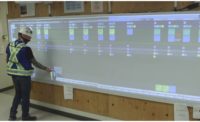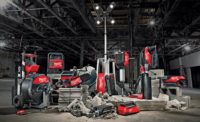Robots made for the construction industry are often pushed as a way to reduce the labor costs of simple, predictable work. But the team at Sarcos Robotics is taking a different tack. “Unlike other robotics companies focused on doing repetitive tasks better, faster and cheaper, we focus on augmenting humans to do non-repetitive tasks,” explains Ben Wolff, CEO of Salt Lake City-based Sarcos Robotics. “An awful lot of things on construction sites are unstructured and non-repetitive. They rely on human intelligence to do things more efficiently.”
This philosophy helps explain Sarcos’ eclectic offering of robots: an untethered, powered exoskeleton, a remotely operated robotic arm and the 16-lb Guardian S robot snake that can roll up stairs and magnetically crawl up vertical ferrous metal surfaces. Each uses robotics to enhance the capabilities of their human operators, allowing robotics to be applied to complex tasks that require human interaction and oversight.
The inspection robot is based on a Sarcos robot developed in 2000 for the U.S. Bureau of Mines as a search-and-rescue tool. The robot features full remote operation and a front-mounted camera, with space for extra sensors to be mounted on its head. Set to launch later this year, the Guardian S will have a base price of about $60,000.
The teleoperated Guardian XC is a track-mounted set of robotic arms that can be run from its integrated platform or remotely, for more dangerous work. Operators can see what the machine sees as they manipulate the arms. Each of the robot’s two arms can lift 500 lb but also has fine enough motor control for tasks such as welding pipe or using tools. Sarcos is currently taking orders for the Guardian XC and the Guardian S.
Sarcos didn’t set out to built robots for construction. Thirty years ago, it began with powered prosthetic limbs and was doing long-term development of robots with the federal Defense Advanced Research Projects Agency. The company was acquired by defense contracting giant Raytheon in 2007, and continued work on military applications for its robots. Sarcos Robotics went independent again in 2014, and has been developing civilian applications for its military-grade robotic offerings.
This complicated history is reflected in the Guardian GT, a powered exoskeleton that grew out of Sarcos’ work at Raytheon. The suit runs off an onboard power source and amplifies the wearer’s strength while reducing fatigue and the chance of repetitive stress injuries. The current prototype only has four to eight hours of battery life, but Wolff says he expects a commercial launch for the exosuit in late 2019 as a leased, robot-as-a-service model. “We see ourselves as a supplier of labor, but in our case it’s robotic labor instead of human labor,” says Wolff. “We can provide one human operator with an exoskeleton that will dramatically increase human efficiency and dramatically reduce the chance of injury.”
Sarcos has announced that several major manufacturers will act as an advisory committee as it commercializes its powered exoskeleton. The team includes representatives from Caterpillar, Bechtel, BMW, Delta Air Lines, GE and other companies in the construction, manufacturing and aerospace industries. “At this time Caterpillar views the exoskeleton suits that Sarcos Robotics is focusing on as a tool that could be utilized on our manufacturing floors to assist workers with lifting and handling parts that are significantly heavier than an unaided worker can safely lift,” says Craig Habeger, division manager for manufacturing technology and solutions in Caterpillar’s innovation and technology development division. “The lift assist not only improves the occupational health of the worker, but can also improve productivity and quality by minimizing worker fatigue.”








_ENRready.jpg?height=200&t=1677786838&width=200)